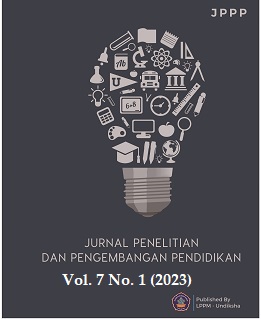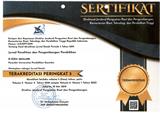The Abilities of Junior High School Students in Solving PISA-Like Mathematical Problems on Uncertainty and Data Contents
DOI:
https://doi.org/10.23887/jppp.v7i1.51931Keywords:
Assessment, PISA-Like, Uncertainty, DataAbstract
Indonesia's participation in PISA is less satisfactory, particularly in mathematics. Uncertainty and data are two of the PISA content areas being evaluated. Therefore the aim of this study is to analyze students' abilities to solve mathematical problems such as PISA on uncertainty and data content to map student readiness for PISA. This study is kind of qualitative study used a case study design. The sample in this study was 84 students of grade IX junior high school who were selected with a simple random sampling technique. The data collection method employs both test and non-test instruments. The data analysis technique used in this study consist of data reduction, data presentation, and conclusion and verification. The results showed that 689 students scored out of 1344, representing 51.41%. These results show that students' ability to solve math problems such as PISA on uncertainty and data content is in the moderate category. While each material, namely statistics and opportunities, is in the high and low categories. This condition is based on learning that has yet to lead students to contextual problems. With these results, it is hoped that there will be efforts to improve the learning process by involving problems such as PISA as habituation.
References
Ahyan, S., Zulkardi, & Darmawijoyo. (2014). Developing Mathematics Problem Based on PISA Level of Change and Realtionship Content. Journal on Mathematics Education, 5(1), 47–56. https://doi.org/10.22342/jme.5.1.1448.47-56. DOI: https://doi.org/10.22342/jme.5.1.1448.47-56
Ambarita, S. M., Asri, L., Agustina, A., Octavianty, D., & Zulkardi. (2018). Mathematical Modeling Skills on Solving PISA Problems. Journal of Physics: Conference Series, 1097(1). https://doi.org/10.1088/1742-6596/1097/1/012115. DOI: https://doi.org/10.1088/1742-6596/1097/1/012115
Arini, N. L. P. D., & Agustika, G. N. S. (2021). Aplikasi Pembelajaran Matematika Berbasis Pendekatan Kontekstual Materi Bangun Datar. Urnal Penelitian Dan Pengembangan Pendidikan, 5(1), 50–59. https://doi.org/10.23887/jppp.v5i1.32357.
Budiono, C. S. (2014). PBM Berorientasi Pisa Berpendekatan Pmri Bermedia LKPD Meningkatkan Literasi Matematika Siswa SMP. Unnes Journal of Mathematics Education, 3(3), 210–219. https://doi.org/10.15294/ujme.v3i3.4487.
Cooke, A., Cavanagh, R., Hurst, C., & Sparrow, L. (2011). Situational Effects Of Mathematics Anxiety In Pre-service Teacher Education. AARE 2011 Conference Proceedings, 1–14. https://espace.curtin.edu.au/handle/20.500.11937/23276.
Damayanti, E. R., & Yunianta, T. N. H. (2018). The Profile of Junior High School Students’ Problem Solving in Answering the Content PISA Test of Uncertainty and Data Based on IDEAL Problem Solving. MaPan: Jurnal Matematika Dan Pembelajaran, 6(2), 250–264. https://doi.org/10.24252/mapan.2018v6n2a10. DOI: https://doi.org/10.24252/mapan.2018v6n2a10
Dewantara, A. H., Zulkardi, & Darmawijoyo. (2015). Assesing Seventh Graders’ Mathematical Literacy in Solving PISA-Like Task. Journal on Mathematics Education, 6(2), 39–49. https://doi.org/10.22342/jme.6.2.2163.117-128. DOI: https://doi.org/10.22342/jme.6.2.2163.117-128
Ekawati, R., Susanti, S., & Chen, J.-C. (2020). Primary students’ mathematical literacy: A case study. Infinity Journal, 9(1), 49–58. https://doi.org/10.22460/infinity.v9i1.p49-58. DOI: https://doi.org/10.22460/infinity.v9i1.p49-58
Fuadi, H., Robbia, A. Z., Jamaluddin, & Jufri, A. W. (2020). Analisis Faktor Penyebab Rendahnya Kemampuan Literasi Sains Peserta Didik. Jurnal Ilmiah Profesi Pendidikan, 5(2), 108–116. https://doi.org/10.29303/jipp.v5i2.122. DOI: https://doi.org/10.29303/jipp.v5i2.122
Hanah, R., Mushetyo, G., & Siswono. (2016). Penggunaan Bahan Manipulatif untuk Memahamkan Materi Peluang pada Siswa SMP dengan Pendekatan Matematika Realistik. Jurnal Pendidikan: Teori, Penelitian, Dan Pengembangan, 1(5), 927–939. https://doi.org/10.17977/jp.v1i5.6312.
Harahap, E. R., & Surya, E. (2017). Kemampuan Pemecahan Masalah Matematis Siswa Kelas VII dalam Menyelesaikan Persamaan Linear Satu Variabel. Edumatica, 7(1), 44–54. http://digilib.unimed.ac.id/id/eprint/26485.
Hewi, & Shaleh. (2020). Reflection of PISA (The Program For International Student Assessment) Results: Improvement Efforts Relying on Early Childhood Education. Journal Golden Age, 4(1), 30–41. https://doi.org/10.29408/goldenage.v4i01.2018.
Hidayah, I. R., Kusmayadi, T. A., & Fitriana, L. (2021). Minimum Competency Assessment (AKM): An Effort To Photograph Numeracy. Journal of Mathematics and Mathematics Education, 11(1), 14–20. https://doi.org/10.20961/jmme.v11i1.52742. DOI: https://doi.org/10.20961/jmme.v11i1.52742
Humaira, M, A., Rasmitadila, Rachmadtullah, R., & Yahya, W. (2019). Using blended learning model (BLM) in the instructional process: teacher student perceptions. Journal of Physics: Conference Series., 1175(2). https://doi.org/10.1088/1742-6596/1175/1/012213. DOI: https://doi.org/10.1088/1742-6596/1175/1/012213
Khasanah, U., Rahayu, R., & Ristiyani. (2021). Analisis Kemampuan Pemecahan Masalah Matematis Siswa Kelas IV Materi Bangun Datar Berdasarkan Teori Polya. Jurnal Didaktika, 1(2), 230–242. https://doi.org/10.17509/didaktika.v1i2.36538.
Kismiantini, Setiawan, E. P., Pierewan, A. C., & Montesinos-López, O. A. (2021). Growth mindset, school context, and mathematics achievement in Indonesia: A multilevel model. Journal on Mathematics Education, 12(2), 279–294. https://doi.org/10.22342/jme.12.2.13690.279-294. DOI: https://doi.org/10.22342/jme.12.2.13690.279-294
Kurniati, D., & Annizar, A. M. (2017). The Analysis of Students’ Cognitive Problem Solving Skill in Solving PISA Standard-Based Test Item. Advanced Science Letters, 23(2), 776–780. https://doi.org/10.1166/asl.2017.7466. DOI: https://doi.org/10.1166/asl.2017.7466
Kurniati, I., Dewi, I., & Hasratuddin. (2018). The Development of Student Worksheet Based on PISA to Improve Problem Solving Ability. American Journal of Educational Research, 6(11), 1581–1585. http://article.scieducationalresearch.com/pdf/education-7-10-1.pdf. DOI: https://doi.org/10.12691/education-6-11-18
Kurniawan, A., Setiawan, D., & Hidayat, W. (2019). Analisis Kemampuan Pemecahan Masalah Matematis Siswa SMP Berbantuan Soal Kontekstual pada Materi Bangun Ruang Sisi Datar. JPMI – Jurnal Pembelajaran Matematika Inovatif, 2(5), 271–282. https://journal.ikipsiliwangi.ac.id/index.php/jpmi/article/view/2976.
Lange, J. de. (2006). Mathematical Literacy For Living From OECD-PISA. Tsukuba Journal of Educational Study in Mathematics, 25, 13–35. https://cir.nii.ac.jp/crid/1520290882875156736.
Lara-Porras, A. M., Rueda-García, M. D. M., & Molina-Muñoz, D. (2019). Identifying the factors influencing mathematical literacy in several Spanish regions. South African Journal of Education, 39, 1–13. https://doi.org/10.15700/saje.v39ns2a1630. DOI: https://doi.org/10.15700/saje.v39ns2a1630
Murtiyasa, B., & Perwita, W. R. G. (2020). Analysis of mathematics literation ability of students in completing PISA-oriented mathematics problems with changes and relationships content. Universal Journal of Educational Research, 8(7), 3160–3172. https://doi.org/10.13189/ujer.2020.080745. DOI: https://doi.org/10.13189/ujer.2020.080745
Muzaki, A., & Masjudin, M. (2019). Analisis Kemampuan Literasi Matematis Siswa. Mosharafa: Jurnal Pendidikan Matematika, 8(3), 493–502. https://doi.org/10.31980/mosharafa.v8i3.557. DOI: https://doi.org/10.31980/mosharafa.v8i3.557
Novita, R., & Putra, M. (2016). Using Task Like PISA’s Problem to Support Students’ Creativity in Mathematics. Journal on Mathematics Education, 7(1), 31–42. https://doi.org/10.22342/jme.7.1.2815.31-42. DOI: https://doi.org/10.22342/jme.7.1.2815.31-42
Nurgiyantoro, B., Lestyarini, B., & Rahayu, D. H. (2020). Mapping Junior High School Students’ Functional Literacy Competence. Cakrawala Pendidikan, 39(3), 560–572. https://doi.org/10.21831/cp.v39i3.34061. DOI: https://doi.org/10.21831/cp.v39i3.34061
Nusantara, D. S., Zulkardi, & Putri, R. I. I. (2021). Designing pisa-like mathematics task using a COVID-19 context (Pisacomat). Journal on Mathematics Education, 12(2), 349–364. https://doi.org/10.22342/JME.12.2.13181.349-364. DOI: https://doi.org/10.22342/jme.12.2.13181.349-364
OECD. (2014). PISA 2012 Results in Focus: What 15-Years-Old Know and What They Can Do with What They Know. OECD Publishing.
OECD. (2019). PISA 2018 Assessment and Analytical Framework (PISA). OECD Publishing. https://doi.org/10.1787/b25efab8-en. DOI: https://doi.org/10.1787/b25efab8-en
Ojose, B. (2011). Mathematics Literacy: Are we able to put the mathematics we learn into everyday use? Journal of Mathematics Education, 4(1), 89–100. https://www.educationforatoz.com/images/8.Bobby_Ojose_--_Mathematics_Literacy_Are_We_Able_To_Put_The_Mathematics_We_Learn_Into_Everyday_Use.pdf.
Oktaviana, Y. I., & Rosyidi, A. H. (2019). Kemampuan Siswa dalam Menyelesaikan Soal PISA Kategori Formulate pada Siswa Kelas VIII. MATHEdunesa: Jurnal Ilmiah Pendidikan Matematika, 8(2), 400–407. https://doi.org/10.26740/mathedunesa.v8n2.p400-407.
Pratiwi, I., Putri, R. I. I., & Zulkardi. (2019). Long Jump in ASIAN Games: Context of PISA-Like Mathematics Problems. Journal on Mathematics Education, 10(1), 81–92. https://doi.org/10.22342/jme.10.1.5250.81-92. DOI: https://doi.org/10.22342/jme.10.1.5250.81-92
Purwanti, K. L., Sukestiyarno, Y. L., Waluya, B., & Rochmat. (2020). The Analysis of Mathematical Literacy Abilities of Primary School Students. International Conference on Science and Education and Technology (ISET 2019), 341–344. https://doi.org/10.2991/assehr.k.200620.066. DOI: https://doi.org/10.2991/assehr.k.200620.066
Risnanosanti, & Ristontowi. (2019). Developing students’ mathematical literacy through DAPIC problem solving process. Journal of Physics: Conference Series, 1321(2). https://doi.org/10.1088/1742-6596/1321/2/022125. DOI: https://doi.org/10.1088/1742-6596/1321/2/022125
Saefurohman, S., Maryanti, R., Azizah, N. N., Al Husaeni, D. F., Wulandary, V., & Irawan, A. R. (2021). Efforts to increasing numeracy literacy of Elementary School Students through Quiziz learning media. ASEAN Journal of Science and Engineering Education, 1(3), 11–18. https://doi.org/10.17509/ajsee.v3i1.38570.
Sari, Y. M., & Valentino, E. (2016). An Analysis of Students Error In Solving PISA 2012 And Its Scaffolding. Journal of Research and Advances in Mathematics Education, 1(2), 90–98. https://doi.org/10.23917/jramathedu.v1i2.3380. DOI: https://doi.org/10.23917/jramathedu.v1i2.3380
Siswono, T. Y. E., Kohar, A. W., Rosyidi, A. H., Hartono, S., & Masriyah. (2018). Searching for Authentic Context in Designing PISA-like Mathematics Problem: From Indoor to Outdoor Field Experience. Journal of Physics: Conference Series, 953(1). https://doi.org/10.1088/1742-6596/953/1/012197. DOI: https://doi.org/10.1088/1742-6596/953/1/012197
Stacey, K. (2010). Mathematical and Scientific Literacy around the World. Journal of Science and Mathematics Education in Southeast Asia, 33(1), 1–16. https://eric.ed.gov/?id=EJ969010.
Stacey, Kaye. (2011). The PISA View of Mathematical Literacy in Indonesia. IndoMS. J.M.E, 2(2), 95–126. https://doi.org/10.22342/jme.2.2.746.95-126. DOI: https://doi.org/10.22342/jme.2.2.746.95-126
Suastika, I. ketut, & Rahmawati, A. (2019). Pengembangan Modul Pembelajaran Matematika Dengan Pendekatan Kontekstual. JPMI (Jurnal Pendidikan Matematika Indonesia), 4(2), 58. https://doi.org/10.26737/jpmi.v4i2.1230. DOI: https://doi.org/10.26737/jpmi.v4i2.1230
Sujadi, I., Budiyono, Kurniawati, I., Wulandari, A. N., Andriatna, R., Puteri, H. A., & Nurmalitasari, A. (2022). Kesulitan Siswa Sekolah Menengah Pertama dalam Menyelesaikan Soal Matematika PISA-Like. Edukasi: Jurnal Pendidikan, 20(2), 315–328. https://doi.org/10.31571/edukasi.v20i2.4781. DOI: https://doi.org/10.31571/edukasi.v20i2.4781
Sumirattana, S., Makanong, A., & Thipkong, S. (2017). Using realistic mathematics education and the DAPIC problem-solving process to enhance secondary school students’ mathematical literacy. Kasetsart Journal of Social Sciences, 38(3), 307–315. https://doi.org/10.1016/j.kjss.2016.06.001. DOI: https://doi.org/10.1016/j.kjss.2016.06.001
Wang, L. (2021). The analysis of mathematics academic burden for primary school students based on PISA data analysis. Frontiers in Psychology, 12(February), 1–9. https://doi.org/10.3389/fpsyg.2021.600348. DOI: https://doi.org/10.3389/fpsyg.2021.600348
Wijaya, A., van den Heuvel-Panhuizen, M., Doorman, M., & Robitzsch, A. (2014). Difficulties in solving context-based PISA mathematics tasks: An analysis of students’ errors. Mathematics Enthusiast, 11(3), 555–584. https://dspace.library.uu.nl/handle/1874/306080. DOI: https://doi.org/10.54870/1551-3440.1317
Yansen, D., Putri, R. I. I., Zulkardi, & Fatimah, S. (2019). Developing PISA-like mathematcs problems on uncertainty and data using Asian Games football context. Journal on Mathematics Education, 10(1), 37–46. https://doi.org/10.22342/jme.10.1.5249.37-46. DOI: https://doi.org/10.22342/jme.10.1.5249.37-46
Yanti, W., Nusantara, T., & Qohar, A. (2016). Analisis Kesalahan dalam Menyelesaikan Soal Pada Materi Permutasi dan Kombinasi. Prosiding Seminar Nasional Pendidikan Matematika 2016, 97–104. https://core.ac.uk/download/pdf/297841820.pdf#page=107.
Zua, B. (2021). Literacy: Gateway to a World of Exploits. International Journal of Education & Literacy Studies, 9(1), 96–104. https://doi.org/10.7575/aiac.ijels.v.9n.1p.96. DOI: https://doi.org/10.7575/aiac.ijels.v.9n.1p.96
Downloads
Published
How to Cite
Issue
Section
License
Copyright (c) 2023 Imam Sujadi, Budiyono, Ira Kurniawati, Arum Nur Wulandari, Riki Andriatna, Hanifa Alifia Puteri

This work is licensed under a Creative Commons Attribution-ShareAlike 4.0 International License.
Authors who publish with the Jurnal Penelitian dan Pengembangan Pendidikan agree to the following terms:
- Authors retain copyright and grant the journal the right of first publication with the work simultaneously licensed under a Creative Commons Attribution License (CC BY-SA 4.0) that allows others to share the work with an acknowledgment of the work's authorship and initial publication in this journal.
- Authors are able to enter into separate, additional contractual arrangements for the non-exclusive distribution of the journal's published version of the work (e.g., post it to an institutional repository or publish it in a book), with an acknowledgment of its initial publication in this journal.
- Authors are permitted and encouraged to post their work online (e.g., in institutional repositories or on their website) prior to and during the submission process, as it can lead to productive exchanges, as well as earlier and greater citation of published work. (See The Effect of Open Access)








